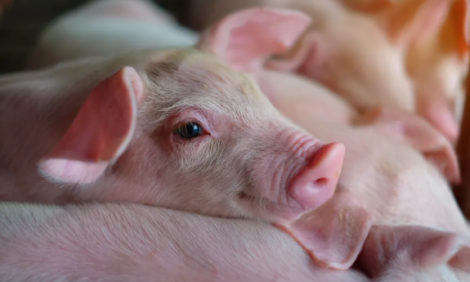



An Industry in Change
Ben Woolley of Sunterra Farms Ltd in Acme, Alberta, gave this presentation at the 2008 London Swine Conference.The difficult part of writing an economic paper for a conference more than a month away is that things change so fast that by the time the conference actually happens, the paper is probably outdated.
On the other hand, my livelihood fortunately does not depend on the predictions being entirely accurate, so I can say what I believe to be true without having to worry too much whether all the prognostications will be fully vindicated!
You will also notice if you take the time to read this, that it is quite different from my actual presentation. In this, I am focusing more on where we are going, whereas in my presentation, I focus more on what got us here. The reason for this is that the paper is more a reference tool to use to make decisions as opposed to me blabbing on about things we need to do to change in the industry as a whole. If you want a copy of the presentation, I will gladly send it to you.
For most producers wrestling with the current crisis, it seems as if there is no future for those who have invested their lives, not to mention their money, in facilities.
The industry has been hit with a series of economic events that have seriously damaged our ability to compete in the international markets.
The strength of the Canadian dollar, along with the weakness of the US dollar, have not only made it difficult to compete for valuable export markets such as Japan and Asia, but have also rendered the industry in Canada higher cost than our US counterparts.
The valuable export market for weaned pigs and feeder pigs to the US is finding it much more difficult to extract profit when the product has been so badly devalued.
In addition to this, packers in Canada have been exposed as high cost and rather inefficient when put next to their US counterparts. If they had been able to maintain premium markets during this time, they would be in much better shape. However, some resorted to dumping product on the market at below market values and so got a reputation of being a low cost producer rather than a value added producer. This was okay with the weak dollar, but when it strengthened relative to the US currency, it exposed this as a short-sighted strategy.
For individual farmers, this can be a pretty demoralizing time. Many have spent years building a business they are proud of. Having to face decisions to shut down these businesses are very difficult to make, and many will fight too long in an attempt to stave off the inevitable.
It is essential to try to take an objective approach to these decisions and to try to detach oneself from the emotion. This can be very difficult when family members may have a different opinion. It is absolutely essential to recognize this and not to get short tempered with family members who are trying to help. Remember that they are feeling the stress as well.
The main decision one needs to face is whether the business can be competitive long term, or whether there is some value added market that can be accessed that allow you to continue to produce but get more from your final product. Pretty obvious stuff; but not always at the forefront of people’s minds when they are considering what to do with their businesses.
The key to making decisions is going to have three aspects to it:
- Can I survive this current crisis without unduly risking all my assets?
- Will I be in good enough shape to take advantage of the markets when they turn, and will the upside be long and strong enough to regain and advance my equity position?
- Will I be able to refine my business to compete?
Unlike most people in the Canadian industry, I see the industry in a position where once the current crisis is past, there may well be a period that will be one of the most profitable we have faced in a long time, if not ever. However it looks likely that most of the benefit will be for those established in the US market in some way.
At the time of writing, there are several factors that are pointing me to this decision:
- Cull sow slaughter in North America is at an all-time high and the packing industry is not able to actually keep up with the number of sows going to market. Farmers in the US who built their units in the late seventies and early eighties are facing losing most of the equity they have built up in the past three years. Many are nearing retirement and do not want to go through another downturn in the industry. They are therefore deciding to close their units down rather than embarking on costly renovations needed.
- We all know the Canadian herd reduction is in full swing. This will decrease the number of animals going to the US for finishing.
- Grain is over priced. The increase has been driven by the shortage of wheat and the ethanol subsidy. There appears to be adequate harvests in Australia and South America; CRP ground will be in production in Europe in 2008; there may be an announcement in the US in the near future that either the ethanol subsidy will be decreased or repealed, or that the import duty on ethanol will be dropped. A half decent harvest in the US and Canada will ensure adequate supplies of grain in the fall and prices will drop accordingly.
You will notice, as I said, that most of this pertains to the US market.
I still do not think it will be as profitable in Canada as in the US as we still have the constrain of the strength of our dollar and the problems in our packing industry.
In addition, if the futures remain as strong as they are at the time of writing, we might see some curtailment in the liquidation which will decrease the strength of the industry revival.
Producers therefore need to decide how to position themselves to take advantage of this and not remain chained to the rather archaic system we have saddled ourselves with in Canada. (More on that in my presentation).
It serves no good to assign blame to individuals for the current situation. However everyone needs to recognize the need for change. Protecting people’s turf at the expense of the betterment of the industry is not only selfish and unhelpful, but also immoral in my mind.
Organizations supported by the industry are there to promote and assist the industry, not to make an easy life for the people who work there. Directors especially are essentially public servants, and should make decisions accordingly.
What do we need to get there?
- We need industry organizations that work hard to identify and promote new value added markets.
- We need to become more competitive as an industry. There are plenty of ways this can be achieved which I will go into in more detail in the presentation.
- We need to be better at risk management.
- All parts of our industry and those servicing the industry need to understand that we have to drive cost out of the system. Feed manufacturers, veterinarians, transporters, drug companies and equipment marketers all need to understand that they will have to survive on lower margins if the industry they serve is to survive.
- We need government to remove the barriers that serve only to decrease the competitiveness of our industry. These include:
- Not supporting industries such as ethanol that add cost to food production without assisting producers as well.
- Not being bullied by the supply-managed agriculture sectors at the WTO negotiations. The beef and pork industries produce far more exports than all the supply-managed industries combined and so are far more affected by trade distortions caused by supporting uncompetitive industries.
- Helping agriculture by allowing producers to recruit staff from overseas instead of throwing every possible encumbrance in the way.
- There is not a lot of point in supporting an industry that cannot compete and repeatedly requires help to survive.
- It needs to change.
- Obviously plants need to become more efficient or carve out a market for themselves that adds enough value to allow them to thrive. The problem with this strategy is that if a market adds enough value to be attractive, no sooner are you servicing it than someone else comes along to service it at lower cost or better. Pretty soon it becomes the norm and you have to find another niche for your product.
The Canadian industry has not done a good job of this. When the Canadian dollar was relatively weak, some in the industry got complacent, as it was easy to export and compete with higher priced product from other producing countries.
Therefore the packing plants need to work hard to become more efficient as well as finding new value-added markets.
In conclusion, we need to get better at what we do. We need to figure out ways to cut costs and add value to what we are producing.
This will require us to basically 'reinvent' our industry in order to compete on the world stage.
There will be opportunities for those positioned to take them both in Canada and in the US.
For those unwilling or unable to change, both in production and in processing and ancillary industries, there is little hope of being able to compete.
This is a new world we are in and we need to adapt.
December 2008
Further Reading
| - | You can view the full proceedings of the 2008 London Swine Conference by clicking here. |








